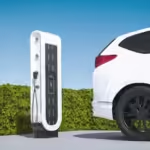
The satellite internet scene is evolving rapidly, and a key player, SpaceX, has recently made a significant upgrade to its Starlink service. The company owned by Elon Musk has released a new version of its consumer kit, which includes an antenna of a non-motorized, stationary design, ushering in an era of enhanced connectivity with an easier setup process.
The Starlink Standard—this latest antenna iteration—requires thoughtful placement within a user’s property to optimize satellite reception. Nonetheless, SpaceX has ingeniously expanded its field of vision for satellite capture by ten degrees, thus simplifying the installation process which the company’s application aids the user through with a comprehensive guide.
Technical advancements don’t stop at the antenna’s new fixed position; the accompanying router has made a generational leap. The introduction of a third-generation Wi-Fi router that operates on the latest Wi-Fi 6 standard significantly boosts theoretical performance levels. This means increased data throughput and expanded coverage area, from the previous 185 square meters up to 297 square meters. Furthermore, the new tri-band operating capability ensures a more reliable connection in a multi-device environment.
Power consumption has seen an uptick, aligning with the enhanced features, while the weather resistance of the apparatus has been improved to meet the IP67 standard, ensuring better durability against harsh environmental conditions.
As for the antenna’s portability, its redesigned slimmer structure facilitates easy transportation, albeit maintaining a similar weight to its predecessor. This is particularly beneficial for the nomadic users taking advantage of the mobile service option, allowing for internet access within Starlink’s coverage zone
The pricing remains competitive and unchanged, still standing at 40 euros monthly, with the hardware available for purchase at 450 euros or a rental option at 10 euros per month. This offering stands in contrast to competitors such as Orange, whose service is priced slightly higher.
ALSO READ John Obi Mikel speaks on which manager’s sacking left Chelsea players really emotional ..‘We all cried’
Current Starlink customers eagerly await details on whether they can upgrade to the new antenna free of charge as part of their subscription, or if it would require purchasing the new kit at full price, highlighting the ongoing customer service considerations that accompany such technological advancements.
FAQ Section
1. What is the new upgrade to SpaceX’s Starlink service?
The upgrade includes a new version of the consumer kit with a non-motorized, stationary antenna and a third-generation Wi-Fi router that supports Wi-Fi 6.
2. How does the new Starlink Standard antenna benefit users?
The antenna requires careful placement to optimize reception but has an extended field of vision by ten degrees, simplifying the installation process.
3. What are the improvements in the new Wi-Fi router?
The new router has increased data throughput and an expanded coverage area. It also features tri-band capability, providing a more reliable connection for multiple devices.
4. Have power consumption and durability been addressed in the new Starlink kit?
Yes, the power consumption has increased due to enhanced features; the weather resistance has been improved to meet IP67 standards for better durability against harsh conditions.
5. Is the new antenna portable?
Yes, the redesigned antenna is easier to transport, maintaining a similar weight to its predecessor, beneficial for users requiring internet access on the go within Starlink’s coverage zone.
6. How has the pricing changed with the new Starlink kit?
The pricing remains competitive and unchanged at 40 euros monthly. Hardware is available for purchase at 450 euros or for rent at 10 euros per month
7. Can current Starlink customers upgrade to the new antenna for free?
It has not been specified whether current customers can upgrade for free or if they will need to purchase the new kit at full price.
Definitions
– Starlink: A satellite internet constellation being constructed by SpaceX providing satellite Internet access coverage to the majority of the Earth.
– Wi-Fi 6: The latest Wi-Fi standard that provides higher data throughput and better performance in environments with many connected devices.
– IP67: A rating indicating that the device is totally protected against dust ingress and can withstand being submerged in water up to 1 meter for 30 minutes.
– Tri-band: A router that operates on three frequencies, typically one 2.4 GHz band and two 5 GHz bands, allowing for more devices to connect without congestion.












